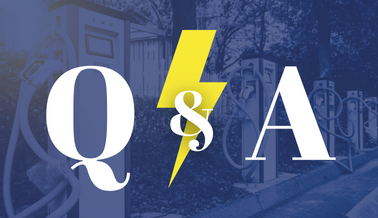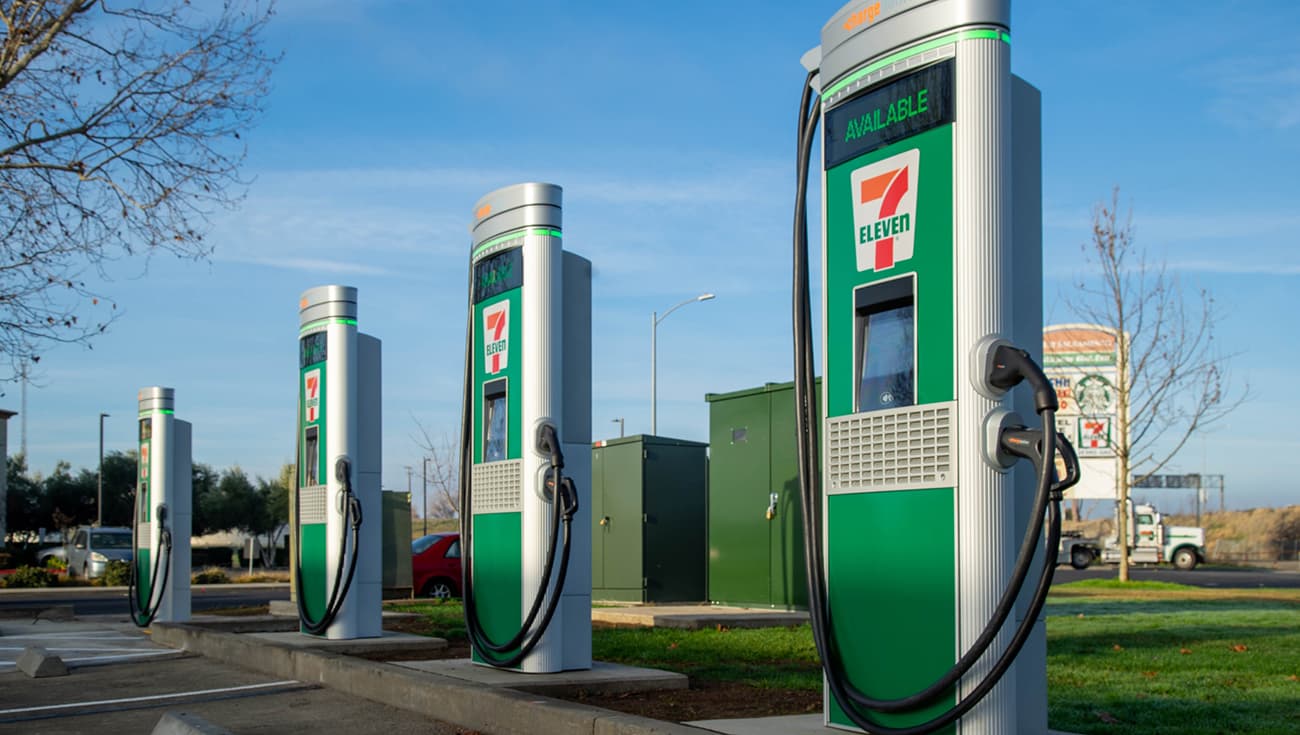Top 7 Questions About the Electric Vehicle Market Answered by Industry Experts

September 7, 2022
In one of our now on-demand webinars, sat down with experts within the manufacturing and electric vehicle industry to hear their thoughts on the growing demand for electric vehicles (EVs) and the impact on the automotive supply chain.
Meet the experts and see the top questions from our webinar, EV Breakthrough!

Lee Lingo - Kentucky Association of Manufacturing
Lee Lingo is the executive director of the Kentucky Association of Manufacturers. With two decades of leadership experience in non-profit management, sales, and marketing, he has successfully worked with stakeholders to strengthen economic opportunities at the local, state, and national levels. A graduate of Murray State University, the US Chamber of Commerce’s Institute for Organizational Management, and Leadership Hopkins County, Lee is a World Trade Center Kentucky Board Member and Certified International Commerce Specialist. He also serves on the Kentucky Community and Technical College Foundation.

Nino Di Cara - Electric Autonomy
Nino Di Cara is the founder and president of Electric Autonomy Canada, the source for professional news, information, and knowledge-sharing on Canada’s transition to electric vehicles, autonomous transportation, and new mobility services. Nino is the recipient of the EV Society’s 2020 Howard Hutt Award for Excellence in the Advancement of Electric Transportation.

James Finlayson - Arcimoto
James Finlayson is a global supply chain manager at Arcimoto, with extensive experience in the consumer electronics, aircraft, military and automotive industries. He has been instrumental in streamlining and improving processes and developing new sources to meet clients’ needs throughout his career. With over twenty years of working with suppliers, he is committed to customer satisfaction, product excellence, and functionality. He collaborates with innovators and manufacturers to develop and refine product concepts, create project plans, define supply chains, and achieve successful product launches on time.

Shawn McEwen - TrueCommerce
Shawn McEwen, regional vice president of automotive and industrial manufacturing at TrueCommerce, served as the guest moderator for this thought leadership webinar. He provides turn-key cloud B2B Managed Services that allows organizations to integrate and exchange critical business documents between trading partners. His proven ability to collaborate across all lines of business with a passion for sparking strategic discussions in the boardroom creates value and builds customer relationships.
Changes to the Automotive Industry
1. What are some insights into the changes we could see in the next three to five years in our economy, including finding and hiring knowledgeable workers?
Lee Lingo: There are several pressures within the workforce right now. There’s the assumption that extra weekly payments are why we don’t have workers back in jobs. That’s only one small part of many contributing factors. Other factors include:
- Unemployment insurance – how easy it is, the duration of receiving it, the amount you pay, and where we are in relation to neighboring states.
- Childcare - the number of women in the workforce was drastically reduced when the pandemic hit because of the lack of access to childcare.
- Ease of education and training – people are limited by their knowledge of the manufacturing industry due to various social constraints.
- Communicating what these jobs are and what they will look like in the future – We will need problem solvers and critical thinkers who can work in a group. This means showcasing what manufacturing is today, as opposed to what people think it is or was in the past, as portrayed on TV and in the media.
2. What are some primary drivers for EV adoption, in regard to cost and infrastructure?
Jim Finlayson: Government investment in the EV market is crucial because historically, governments that played a role investing in batteries, chip production, battery recycling, motor technology, and high volt electronics have progressed more substantially. That is what will drive the electric vehicle industry.
Nino Di Cara: Additionally, EV charging stations are going to be a big issue. We don’t want to rush in and build an infrastructure that won’t support the cars built within the next few years. There is only a 3.5% adoption rate of EVs in Canada as a percentage sold of new vehicles.
To transition to 90% – 95% of the vehicles on the road (private and public, and commercial fleets) to electric, we’re going to need substantially more public charging infrastructure than we currently have – and we need that investment to come from lots of places. The government investment is huge, as well as companies introducing their fleets and investing in their own depot charging. An area that we’ll need to see a lot more action from is utilities. They have a lot to gain from the transition to EV adoption.

Challenging How We Think About Transportation
3. What do you see changing in regard to transportation and the way we view it?
Lee Lingo: EV technology is burgeoning, and it’s massive. There was a time when it was just Tesla, but now you hear about all the other companies and their successes and failures.
EV adoption is going to be a slow transition because many people like and understand what they have. They understand going to the gas pump, filling it up, checking the oil, etc. EV technology is new and different, making it more challenging to adopt. Still, we’ll begin to see more people who can lean into this as these vehicles become more affordable and the technology better understood.
With products like the lightning models, there will be people who never would have thought of purchasing an EV now considering it an option. It will look like a model they know (while being slightly different), and they’ll be more comfortable and willing to adopt that change. We can already see people outside of the target group that we’d expect to buy an EV making this shift, but this doesn’t necessarily mean we’re going to see a loss of fossil fuel vehicles anytime soon.
4. What about the bus market and industrial machines, such as heavy-duty trucks and bulldozers?
James Finlayson: As an example, in Shenzen, China, the Chinese government said to them, “We’ll give you one hundred thousand dollars for every bus you take out of service.” Now, in a city of 14 million people, there are only electric buses and cabs.
Shawn McEwen: In an article from Charged Electric Vehicle Magazine, Nuvve Holding, the developer of a proprietary vehicle-to-grid (V2G) platform, and iconic school bus manufacturer Blue Bird plan to use the financing resources of Levo Mobility to allow customers to lease V2G-enabled electric school buses, charging infrastructure and energy management for a flat monthly fee. This Fleet-as-a-Service (FaaS) solution is designed to enable fleets to electrify quickly with no upfront costs and full financing options.
Nino Di Cara: It’s an exciting experiment to electrify. McLane Engineering has some fantastic underground mining vehicles that are fully battery-electric in a mining context. Mine operators were expecting to save money on the fuel they were using, switching out diesel for an electric vehicle, but the enormous savings have come from HVAC. They don’t have to extract all the pollution that the combustion engine created underground. This has improved the working environment enormously because there’s less noise, fewer vibrations, and way fewer pollutants coming out of those machines.
There continues to be a challenge with the power density needed to operate other vehicles, like snowplows. Still, there are some market options for electric garbage trucks and firetrucks, which is great because they work in our communities. Electrifying these types of vehicles eliminates a significant amount of noise and air pollution as you’re walking around your neighborhood. Forklifts are a possible scenario within a warehouse application, and drayage applications at ports have good potential for electrifying.
Identifying Opportunities in the EV Market
5. What are some challenges we’re going to face with the EV market, and alternatively, what are some opportunities?
Lee Lingo: Some challenges that we can expect to face are:
- Range anxiety - the fear factor still exists. Many people will be more hesitant about an electric firetruck because of the fear that it will run out of charge on the way to an emergency. The average person only drives about 20-30 miles a day, but an overwhelming number of consumers still say that a range of over 200 miles is not enough.
- Material investment and production - creating sustainable batteries and efficient charging stations to support more electric vehicles.
- Adoption rate - people are accustomed to what they know, and even if they’re open to a change, people like having choices. There are more options for gasoline combustion vehicles on the market right now than there are for electric vehicles.
Price and visibility are going to be key. As we see visibility in the news increase, it will continue to grow as those models proliferate. Prices will then adjust based on availability and demand
There are also significant opportunities for city tourism with electric scooters and EVs for delivery methods. For example, Domino’s experimented with some exciting ways of doing autonomous delivery and things of that nature.
James Finlayson: The COVID pandemic has allowed us to bring on hundreds of remote engineers who are not at the facility but are actively working on new designs, electronics, and models. Previously, you’d have had to move them onsite, but now you don’t. This has created a significant opportunity in employment for developing these new EVs.
Enabling Integration Technologies to Drive & Manage Global Business Processes
6. How do we scale EV demand within the supply chain?
Nino Di Cara: Scaling EV demand within the supply chain will be similar to handling the combustion engine supply chain. Throughout Covid and especially when the Ever Given got stuck in the canal, we’ve seen the vulnerability and fragility of supply chains. It’ll come down to the material sourcing and manufacturing capabilities for these vehicles. Are we merely going to export raw materials, or will we build the batteries and components locally to create those jobs here? It’s critical supply chain security, and it will be important to have integrated systems to know precisely what’s going on at each step.
7. How do we overcome the various barriers to entry in regard to production?
James Finlayson: When you’re in the automotive industry, safety is a major concern. You have to be certified to supply automotive OEMs. Small companies will have a more difficult time qualifying at an automotive OEM, which is why many tend to go with larger suppliers.
Currently, the most significant barrier to entry is acquiring the batteries, chips, and various parts for manufacturing more EVs. It’s easy to get stuck in a single-source arrangement, so what happens if they decide not to sell to you, they run out, or they run a part shortage or a secondary part shortage? To overcome this, OEMs will need to utilize multiple manufacturing facilities around the world while controlling supply chain processes to ensure quality and safety standards.
With the adoption of electric vehicles on the rise, and many companies and governments investing in the movement, the automotive supply chain needs to evolve as well. As OEMs experience production delays due to shortages and lack of visibility, now more than ever is the time to rethink your global supply chain. Enabling integration technologies can provide insights and streamline processes to create an effective go-to-market strategy.
Check out the complete webinar by registering to receive a recording of ‘EV Breakthrough!‘ and be on the lookout for future webinars on this pivotal topic.
About the Author: Shawn McEwen, regional vice president of automotive and industrial manufacturing at TrueCommerce, is a business leader who enjoys building bridges within Automotive Supply Chain & IoT segments. He provides turn-key cloud B2B Managed Services that allows organizations to integrate and exchange critical business documents between trading partners. His proven ability to collaborate across all lines of business with a passion for sparking strategic discussions in the boardroom creates value and builds customer relationships.
Share this post:
Stay ahead of the competition
Get expert supply chain insights delivered directly to your inbox weekly.